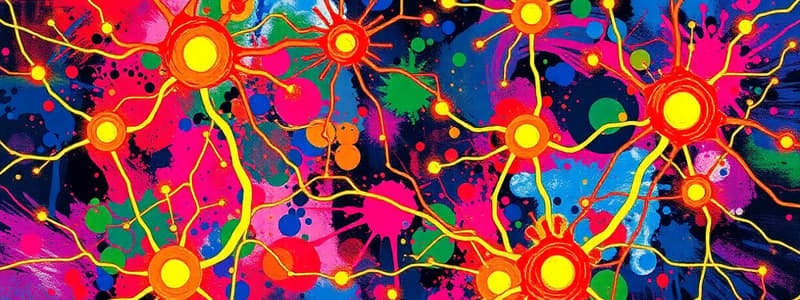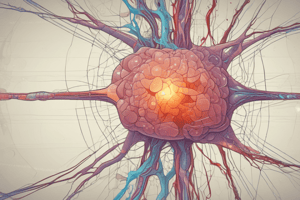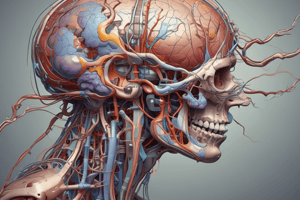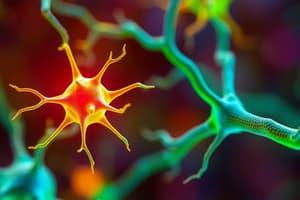Podcast
Questions and Answers
Why does the intracellular fluid have a higher concentration of potassium ions (K+) than the extracellular fluid?
Why does the intracellular fluid have a higher concentration of potassium ions (K+) than the extracellular fluid?
- The cell membrane is more permeable to potassium ions than to sodium ions, allowing potassium ions to diffuse out of the cell.
- Potassium ions are actively transported from the extracellular fluid into the intracellular fluid by a membrane pump. (correct)
- The cell membrane is more permeable to sodium ions than to potassium ions, allowing sodium ions to diffuse into the cell.
- Potassium ions are actively transported from the intracellular fluid to the extracellular fluid by a membrane pump.
Which of the following statements accurately describes the resting membrane potential?
Which of the following statements accurately describes the resting membrane potential?
- The resting membrane potential is a result of the equal distribution of charges across the cell membrane.
- The resting membrane potential is maintained by the continuous movement of ions across the cell membrane, primarily through passive diffusion.
- The resting membrane potential is always positive because of the higher concentration of sodium ions outside the cell.
- The resting membrane potential is always negative because of the higher concentration of potassium ions inside the cell. (correct)
What is the approximate value of the resting membrane potential in a typical neuron?
What is the approximate value of the resting membrane potential in a typical neuron?
- -30 mV
- +30 mV
- +70 mV
- -70 mV (correct)
How do negatively charged ions contribute to the resting membrane potential?
How do negatively charged ions contribute to the resting membrane potential?
Which of the following factors significantly influences the resting membrane potential of a cell?
Which of the following factors significantly influences the resting membrane potential of a cell?
What is the primary function of the nervous system in animals?
What is the primary function of the nervous system in animals?
Sensory receptors, a specialized type of neuron, are responsible for:
Sensory receptors, a specialized type of neuron, are responsible for:
Which of the following is NOT a major role of the nervous system?
Which of the following is NOT a major role of the nervous system?
What is a synapse?
What is a synapse?
Which of the following statements about the nervous system and the endocrine system is TRUE?
Which of the following statements about the nervous system and the endocrine system is TRUE?
What is an effector in the nervous system?
What is an effector in the nervous system?
What is the difference between a neuron and a nerve?
What is the difference between a neuron and a nerve?
How does the nervous system and the endocrine system work together to maintain homeostasis?
How does the nervous system and the endocrine system work together to maintain homeostasis?
Which of the following statements accurately describes the role of electrotonic potentials in initiating an action potential?
Which of the following statements accurately describes the role of electrotonic potentials in initiating an action potential?
Which of the following is a key reason why an action potential cannot be triggered during the refractory period of an axon?
Which of the following is a key reason why an action potential cannot be triggered during the refractory period of an axon?
Which of the following best explains why electrotonic potentials are limited to short distances along the membrane?
Which of the following best explains why electrotonic potentials are limited to short distances along the membrane?
What is the significance of the rapid, but brief, depolarization phase of an action potential?
What is the significance of the rapid, but brief, depolarization phase of an action potential?
How does the refractory period contribute to the unidirectional propagation of action potentials along an axon?
How does the refractory period contribute to the unidirectional propagation of action potentials along an axon?
What is the primary factor that determines the direction of ion movement through an open K+ channel at rest?
What is the primary factor that determines the direction of ion movement through an open K+ channel at rest?
Which of the following statements accurately reflects the relationship between changes in membrane permeability and graded potentials?
Which of the following statements accurately reflects the relationship between changes in membrane permeability and graded potentials?
How do electrotonic potentials differ from action potentials?
How do electrotonic potentials differ from action potentials?
Why are graded potentials considered "graded"?
Why are graded potentials considered "graded"?
Why are electrotonic potentials considered "local"?
Why are electrotonic potentials considered "local"?
Which of the following best describes the relationship between graded potentials and action potentials in neurons?
Which of the following best describes the relationship between graded potentials and action potentials in neurons?
How does the opening of a K+ channel at rest affect the membrane potential?
How does the opening of a K+ channel at rest affect the membrane potential?
What is the relationship between the shape of a channel protein and its ability to open and close?
What is the relationship between the shape of a channel protein and its ability to open and close?
Which of the following statements accurately describes the role of Na+ and K+ channels in the falling phase of the action potential (AP)?
Which of the following statements accurately describes the role of Na+ and K+ channels in the falling phase of the action potential (AP)?
What is the critical role played by voltage-gated sodium (Na+) channels in the rising phase of the action potential?
What is the critical role played by voltage-gated sodium (Na+) channels in the rising phase of the action potential?
Which of the following factors is responsible for the brief hyperpolarization phase that occurs after the falling phase of the action potential?
Which of the following factors is responsible for the brief hyperpolarization phase that occurs after the falling phase of the action potential?
What is the role of K+ leak channels in establishing and maintaining the resting membrane potential?
What is the role of K+ leak channels in establishing and maintaining the resting membrane potential?
Why is the action potential considered an 'all-or-nothing' event?
Why is the action potential considered an 'all-or-nothing' event?
Which of the following statements accurately describes the mechanism by which action potentials propagate along an axon?
Which of the following statements accurately describes the mechanism by which action potentials propagate along an axon?
What is the primary function of the Na+/K+ pump in maintaining the resting membrane potential and the concentration gradients of Na+ and K+ ions?
What is the primary function of the Na+/K+ pump in maintaining the resting membrane potential and the concentration gradients of Na+ and K+ ions?
What role does the initial depolarization play in the Hodgkin-Huxley cycle?
What role does the initial depolarization play in the Hodgkin-Huxley cycle?
In unmyelinated axons, what primarily determines the speed of action potential conduction?
In unmyelinated axons, what primarily determines the speed of action potential conduction?
What mechanism prevents backpropagation of the action potential in unmyelinated axons?
What mechanism prevents backpropagation of the action potential in unmyelinated axons?
What characterizes saltatory conduction in myelinated axons?
What characterizes saltatory conduction in myelinated axons?
Which channel concentration is notably high at the axon hillock?
Which channel concentration is notably high at the axon hillock?
What effect does the larger diameter of an axon have on action potential conduction?
What effect does the larger diameter of an axon have on action potential conduction?
What is the primary consequence of Na+ channel opening during depolarization?
What is the primary consequence of Na+ channel opening during depolarization?
Which statement best describes the propagation of action potentials along axons?
Which statement best describes the propagation of action potentials along axons?
Flashcards
Electrochemical Potentials
Electrochemical Potentials
Electric charge difference across a neuron's membrane that drives signal transmission.
Neuron
Neuron
An individual cell in the nervous system that transmits information.
Nerve
Nerve
A bundle of axons that transmits signals together, not a single neuron.
Axon
Axon
Signup and view all the flashcards
Synapse
Synapse
Signup and view all the flashcards
Effector
Effector
Signup and view all the flashcards
Sensory Receptors
Sensory Receptors
Signup and view all the flashcards
Homeostasis
Homeostasis
Signup and view all the flashcards
Resting Membrane Potential
Resting Membrane Potential
Signup and view all the flashcards
Ion Concentration
Ion Concentration
Signup and view all the flashcards
Na+ and K+ Role
Na+ and K+ Role
Signup and view all the flashcards
Unequal Charge Distribution
Unequal Charge Distribution
Signup and view all the flashcards
Intracellular and Extracellular Fluid
Intracellular and Extracellular Fluid
Signup and view all the flashcards
Action Potential
Action Potential
Signup and view all the flashcards
Threshold Value
Threshold Value
Signup and view all the flashcards
Depolarization
Depolarization
Signup and view all the flashcards
Voltage-gated Na+ Channels
Voltage-gated Na+ Channels
Signup and view all the flashcards
Falling Phase
Falling Phase
Signup and view all the flashcards
Repolarization
Repolarization
Signup and view all the flashcards
Hyperpolarization
Hyperpolarization
Signup and view all the flashcards
Refractory Period
Refractory Period
Signup and view all the flashcards
Electrotonic Potentials
Electrotonic Potentials
Signup and view all the flashcards
Action Potential (AP)
Action Potential (AP)
Signup and view all the flashcards
Threshold Potential
Threshold Potential
Signup and view all the flashcards
Hodgkin-Huxley Cycle
Hodgkin-Huxley Cycle
Signup and view all the flashcards
Axon Hillock
Axon Hillock
Signup and view all the flashcards
Unmyelinated Axons
Unmyelinated Axons
Signup and view all the flashcards
Myelinated Axons
Myelinated Axons
Signup and view all the flashcards
Saltatory Conduction
Saltatory Conduction
Signup and view all the flashcards
Na+ Channels
Na+ Channels
Signup and view all the flashcards
K+ Channel at Rest
K+ Channel at Rest
Signup and view all the flashcards
Gated Channels
Gated Channels
Signup and view all the flashcards
Polarization in Cells
Polarization in Cells
Signup and view all the flashcards
Graded Potentials
Graded Potentials
Signup and view all the flashcards
Electrotonic Potentials (EP)
Electrotonic Potentials (EP)
Signup and view all the flashcards
Study Notes
Animal Body Systems - Electrochemical Potentials in Neurons
- Neural function relies on electrochemical potentials.
- Lectures cover electrochemical potentials in neurons.
- Supplementary reading recommended: Textbook (15th Edition, Chapter 42, pages 1123-1137).
Review General Concepts
- Organ systems must coordinate within an animal and with the environment.
- Two major systems involved in this coordination are nervous and endocrine.
- These systems work together to create complex homeostasis.
Nervous Systems
- Nervous systems are rapid coordination/regulation systems in all animals except sponges.
- Major roles of nervous systems include:
- Collecting information from internal or external environments using modified neurons (sensory receptors).
- Processing and integrating information (evaluating information based on past experiences and genetics.)
- Transmitting information to coordinate/regulate effector organs/cells.
Terminology
- Neuron: An individual nerve cell.
- Nerve: A bundle of axons (not the entire neuron).
- Axon: Also called a nerve fiber.
- Synapse: The connection between the axon terminal and the effector cell (synaptic cleft).
- Effector: Can be a neuron, muscle cell, or another type of cell (e.g., gland).
Bioelectricity
- Bioelectricity occurs at the membrane; all processes occur here.
- Potential: Difference in electrical charge between regions, measured in volts (V) or millivolts (mV).
- Current: Flow of electrical charge between regions. Opposite charges attract, like charges repel. Differences in charge from inside to outside influence the current
- Membrane potential: Unequal charge distribution across a cell membrane.
Cells are Polarized
- All living cells have a membrane potential (MP).
- The inside of a cell membrane is negative relative to the external side.
- The range of MP is from -10 mV to -90 mV.
Excitable Cells
- Neurons and muscle cells are excitable and have large membrane potentials.
- Mechanisms regulate membrane potentials and currents.
- Three types of membrane potentials include resting, electrotonic, and action potentials.
- Membrane potentials and currents depend on inorganic ions.
Resting Membrane Potential of a Cell
- All cells have a resting MP.
- Measured when the cell is inactive.
- MP results from an unequal distribution of positive and negative charges across the cell membrane.
- The resting potential creates a potential difference across the membrane, which is primarily controlled by Na⁺ and K⁺ ions, and other ions.
Ion Concentrations in Cells
- Extracellular fluid has a high concentration of Na⁺ and a low concentration of K⁺.
- Intracellular fluid has a high concentration of K⁺ and a low concentration of Na⁺.
- Embedded proteins (e.g., sodium-potassium pump) control ion concentrations in cells. Active transport is involved.
Ion Gradients in all Cells
- Ion gradients are maintained by active transport (energy required, requiring ATPases).
- Na⁺/K⁺ ATPase moves three Na⁺ ions out and two K⁺ ions into the cell.
- It's an electrogenic pump.
- It generates a -10mV potential.
- Anionic proteins generate a -5 mV potential.
- All cells have ions gradients
The Additional Potential in Neurons
- Passive diffusion of K⁺ through open K⁺ channels contributes to membrane potential.
- Chemical gradient for K⁺; no electrical gradient.
- ATPase and leak channels together create an electrochemical gradient.
Resting Potential of Neurons
- Na⁺/K⁺ active transport pump sets up concentration gradients for Na⁺ and K⁺ ions.
- Open channels (leak channels) allow K⁺ to flow out freely.
- Negatively charged molecules (anions) in the cell cannot pass through the membrane.
- Standard resting membrane potential value (-70 mV). The value can vary, but is a good baseline.
Membrane Ion Channels
- Ion channels are specific for each ion.
- Leak channels are always open (e.g., K+ channel at rest).
- Other channels are regulated (gated) and can change shape to open/close (e.g., in neurons).
- Gated channels are often voltage-gated in neurons.
- Ion movement depends on the concentration gradient.
Polarization in Cells
- Cells are polarized with a negative inside.
- Cells can depolarize (more +ve inside) or hyperpolarize (more -ve inside).
- Electrotonic potentials (EP) and action potentials (AP) involve changes in potential.
- APs are rapid changes in membrane potential.
- EPs are small changes in membrane potential.
Graded Potentials
- Changes in membrane potential due to ion permeability changes are graded potentials.
- In neurons, these are parts of integration in dendrites and cell bodies.
- Electrotonic potentials are one type of graded potential. Not enough to cause action potential
Electrotonic Potentials
- Electrical currents traveling along the membrane.
- Small changes in potential (a few mV).
- Can depolarize or hyperpolarize.
- Travel a short distance.
- Used to initiate action potentials in axon hillock.
- Also used in conducting APs along axons.
Action Potentials
- Action potentials begin at the axon hillock and propagate down the axon.
- Action potentials are found only in nerve axons.
- Action potentials carry signals from axon hillocks to terminals.
- Depolarization to the level of +35 mV.
- Quick and brief change in potential. Not always a long event.
- Entire axon is involved.
- Relies on ion currents via voltage-gated channels for propagation.
Generation of an Action Potential
- Occurs when a stimulus raises resting potential to threshold value.
- Voltage-gated Na⁺ and K⁺ channels open in the plasma membrane.
- Inward flow of Na⁺ changes potential from negative to positive.
- Potential falls to resting value due to gated K⁺ channels.
Depolarization (Rising Phase of AP)
- Action potential depends on ion currents and voltage-gated channels.
- Na⁺ - voltage gated sodium channel
- K⁺ - voltage gated potassium channel
- NOTE: K⁺ leak channels are always open. This is a crucial ion channel in the maintenance of resting potential.
Falling Phase of AP
- Action potential depends on ion currents and voltage-gated channels.
- K⁺ channel opens. K⁺ flows out.
- Repolarization occurs.
The Hodgkin-Huxley Cycle
- The rise phase of AP is positive feedback.
- Initial depolarization opens Na⁺ channels, increasing permeability to Na⁺.
- Increased Na⁺ flow leads to further depolarization, completing the cycle.
AP Propagation Along Axon
- Action potential is initiated in the axon hillock and is carried down the axon.
- The signal moves without change in strength.
- Dendrites and cell bodies have K⁺ channels reducing signal strength moving back to the soma.
Propagation of an Action Potential
- Generated in one segment from ion flow, depolarizing the next segment.
- This process repeats.
- Applies to both myelinated and unmyelinated axons.
AP Conducton in Unmyelinated Axon
- Reduced threshold at the axon hillock.
- Concentration of Na⁺ channels.
- Current spreads along the membrane toward terminals.
AP Conduction in Myelinated Axon
- Myelin (protein and lipid) insulates the axon, preventing ion flow across the membrane.
- Reduces current loss.
- Concentration of Na⁺ and K⁺ at nodes allows ions to cross the membrane.
- Saltatory conduction occurs (jumping between nodes).
### Something to Think About
- Vertebrates requiring higher action potential conduction velocities.
Studying That Suits You
Use AI to generate personalized quizzes and flashcards to suit your learning preferences.




